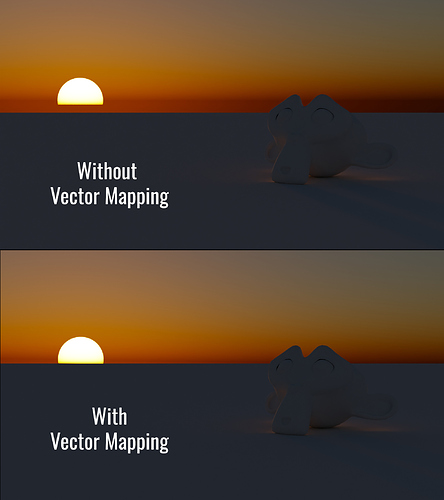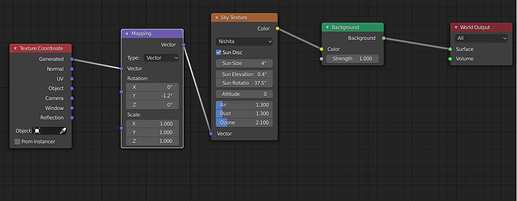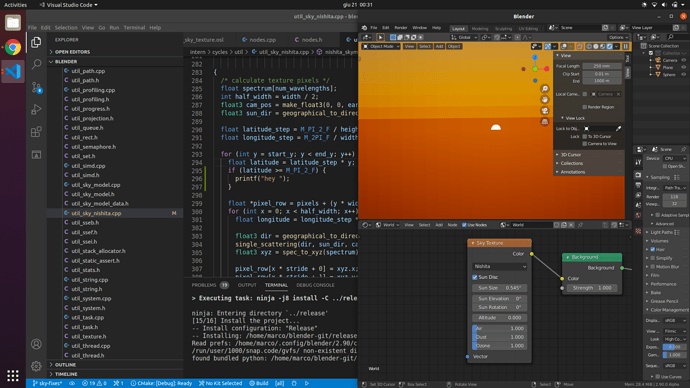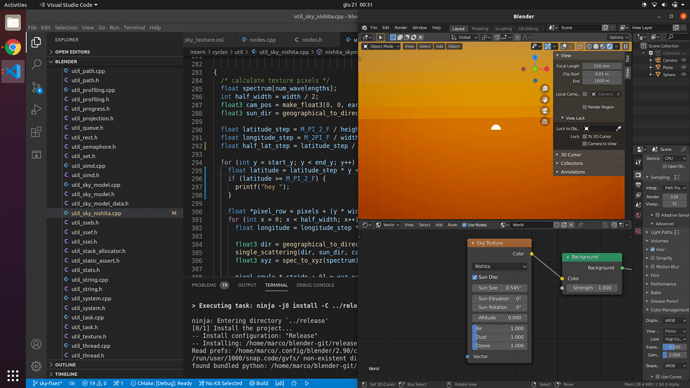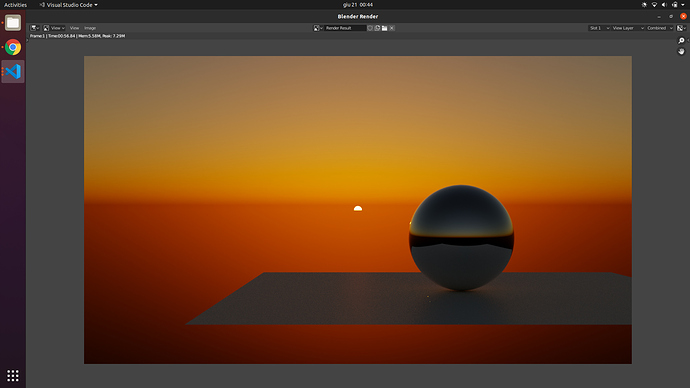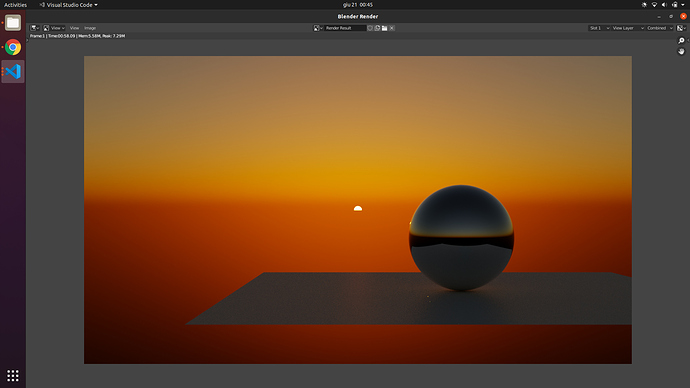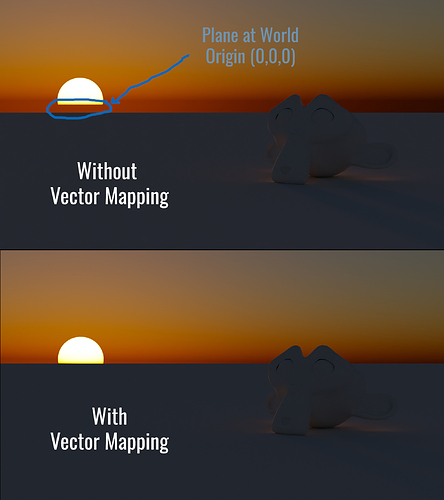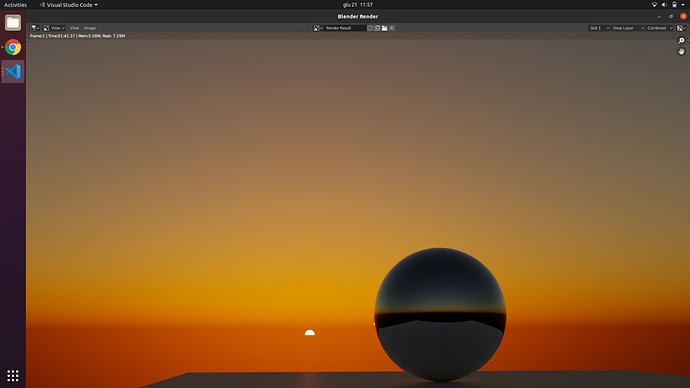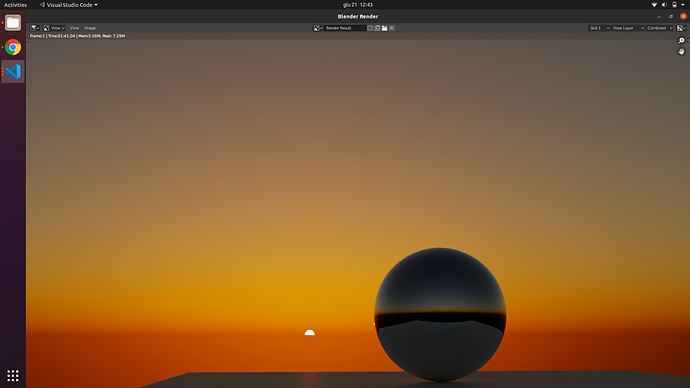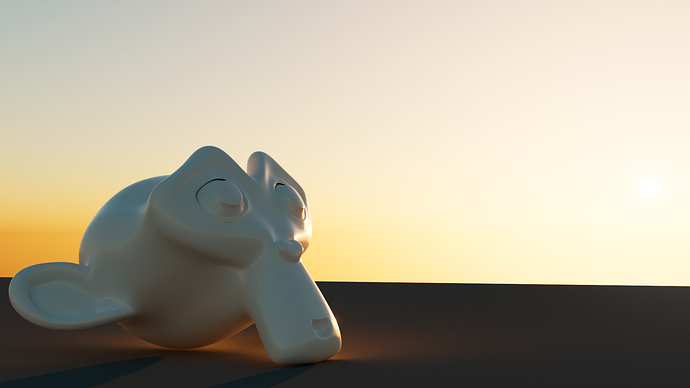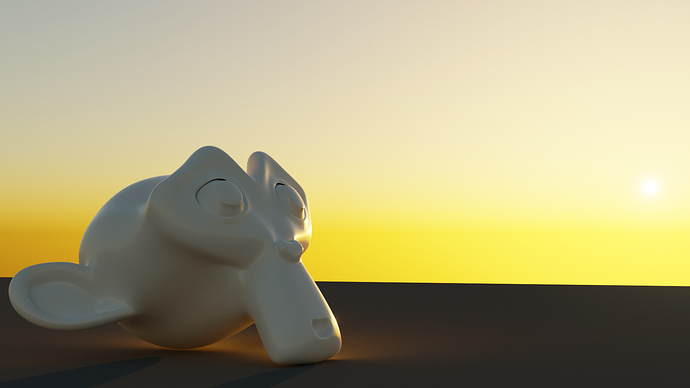Well, that’s why it’s called sky texture 
Indeed 
Now you could make a Volumetric Sky shader 
thanks! now i get it
Regarding to removing the Vector Input, I think it should be reconsidered, since it allows a more artistic control in correcting the horizon line.
We know, but there is a serious issue, try setting the Sun Size to default 0.545 on that scene, and try maybe to rotate slightly the Z axis, you will see the sun lighting disappearing on your models. That’s because of MIS that could miss the sun disc and so its lighting. The only way to know the position of the sun in the sky is through the Sun Elevation and Sun Rotation only.
Try at different angles with the mapping node and you will see why we are considering to remove the Vector input.
I don’t like the solution either, but if it’s going to avoid a lot of people to report the same “missing lighting from sun disc” problem then we think it’s the only viable way
I see, thanks for the info, I’ve been trying this cool new texture for a couple of days and found this little issue with the horizon line (by the way, the scene is just a simple plane at the world origin, and Suzanne), and the only solution I found was this little trick using Vector Mapping, but I understand that solving this little issue will come with more problems. So yes, the best option is to remove the Vector Input
Oh, about the horizon “issue”, it’s not an issue but could be because of the 512 x 128 precomputed texture that is being interpolated (being it low res then it’s not perfect)
(These renders show the sky sampled with the raw pixels map instead of the interpolated one)
Before:
Now:
In the end decided to give a “fix” for that, it now samples the pixels at the center rather than at the edges producing a slightly less noticeable horizon line.
Will create a new branch soon so that you can all try the new fixes.
Also trying Cubic interpolation versus the actual Linear seems to give much smoother results without losing too much performance!!
Before (Linear interpolation):
Now (Cubic interpolation):
Oh haha, the “issue” I was referring about the horizon line was about the Sun and the gap produced when is near “Z=0” world coordinate. But that improve of Cubic Interpolation looks pretty good
That’s because your plane is not large kilometers, you camera end clip could be lower than the length of the plane and the camera position is not at the same altitude of the plane.
Anyway, since Cubic interpolation takes considerably longer for renders with more samples then i decided to switch back to Linear but ![]() sample more pixels towards the horizon.
sample more pixels towards the horizon.
Before:
After:
This trick is cool because the more visible color changes happen near the horizon, so if we sample more pixels towards it then we can get rid (as you can see in the image) of the horizon “too high” artifact without any performance drawback!
This is not how the moon works. Other than orbiting the Earth in roughly the same plane the Earth orbits the sun, It moves independently of the sun and can, in fact, also be seen during the day. In fact, this is how we get solar eclipses.
There are a bunch of awesome effects that a moon would be cool to have for, but I think in many ways it’s actually more complicated, especially when the sun and moon may interact via occlusion. The moon also has a discernible texture and even bumps which do come into play sometimes (mostly during the aforementioned solar eclipse)
I think properly implementing the moon would be much more complex than you might think. Definitely well out of scope for this
Oh yes, my bad, sorry for that. Thanks for the fix of the interpolation, the horizon looks more consistent now
Why cut off the sun disc at all ? Not doing it would basically solve the horizon offset problem I think ?
The horizon is as it is, it should not be offset at all, anyway with the upcoming commit it’s going to be less visible.
Good point about the sun that should go lower the horizon… will think about that.
I was doing a comparison of the new sky texture in ACES vs the existing OCIO config, and something seems a little weird
ACES (ACEScg rendering space, OCIO XYZ role set)
Current config (Filmic+high contrast look)
What’s up with the bright yellow stripe along the horizon with the current config (linear sRGB rendering space)?
Just out of curiosity, can other “atmosphere” can be simulated with this ?
something like :
chees.
L.
This is a sky texture, not a “other planets” atmosphere texture, so no it doesn’t. You can get similar results though tweaking the Density parameters a bit.
nothing prevents you to use a hue/saturation node on the sky texture output
Please consider the following quality of life change for easy 1 to 1 driver setup with the sun lamp:
Match the sun rotation and sun elevation to the X and Z rotation values of a lamp in order to easily drive the node’s parameters with the rotation of the lamp.
Elevation has a 90 degree offset compared to the sun lamp’s X axis and Rotation is flipped compared to the sun lamp’s Z axis.
The other change would be to allow for continuous rotation in the Elevation and Rotation values as well as negative values, again so it doesn’t interfere with rotations coming from the sun lamp object.
